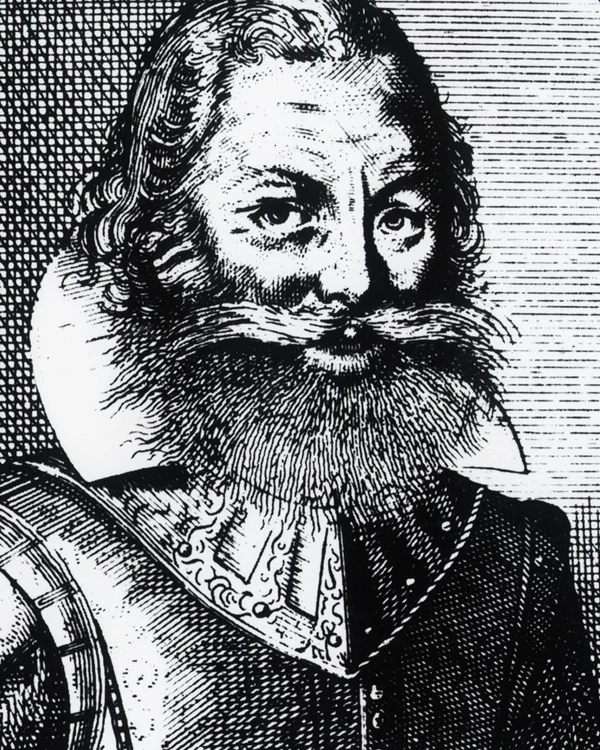Last updated: February 23, 2024
Person
John Smith

NPS
Captain John Smith was an English soldier who played a pivotal role in the establishment of permanent English colonies in the Americas. His leadership of the failing Jamestown colony, his writings and maps, as well as his negotiations with Native peoples were invaluable to both the Virginia Company of London and the Plymouth colony in Massachusetts. His story has lessons to teach us about the origins of America, government-to-government relations, and the troubled legacy of colonialism.
Life Before Jamestown
John Smith was born to middle-class farming family in Willoughby, England, either late in 1579 or early 1580. Elizabethan England had a rigid class structure, and Smith was destined to become a farmer like his father. However, when he was 16, Smith left home to become a soldier. He fought in Europe and the Middle East, rising to the rank of Captain. In Turkey, he was captured and sold into slavery, but eventually he escaped. After further campaigns in Europe and Africa, he returned to England in 1605.
John Smith in Virginia
At age 27, Captain John Smith was one of the 105 colonists who embarked on the first Virginia Company of London expedition to the Chesapeake region. During the voyage, he was accused of mutiny and imprisoned on board the ship. In the spring of 1607, the colonists landed and founded the settlement of Jamestown. Smith’s fortunes changed on arrival when letters of instruction from the Virginia Company named him to the new settlement’s governing council.
In the winter of 1607, Smith was captured by the chief of the Pamunkey people, Opechancanough. He was then taken to the highest authority in the land, paramount chief Powhatan in his capital town of Werowocomoco. While captive there, Powhatan subjected Smith to several ceremonial events which Smith describes in his journals. The most famous of these is the instance involving Powhatan’s young daughter, Pocahontas, though historians have questioned Smith’s version of this event.
Whatever the case, Smith was released from Werowocomoco with the understanding that he was entering into a trade relationship with Powhatan. Jamestown was expected to pay tribute, or taxes as we might call them today, to Powhatan in the form of English weapons and other goods. In exchange, Powhatan would supply food to the hungry colonists.
The Virginia Company of London was a private company with a board and investors, much like companies today. While permission for the attempt was given by King James I, the crown provided no funding for the colony. Thus, the company’s first priority was to discover a way to make the Jamestown settlement profitable and provide a return on their investment.
As part of this effort, John Smith set out on two long, exploratory voyages throughout the Chesapeake Bay and its tributaries in the summer of 1608. He was hoping to find what the Spanish had exploited in South America: gold and silver. Second, he would search for a “Northwest Passage,” a water route connecting the northern Atlantic and Pacific oceans. Any city at the entrance to this passage would have instantly became a center of global trade, though today we know that no such route existed.
Instead of a Northwest Passage or precious metals, the voyages resulted in a detailed map and written documentation of the area’s Indigenous communities and geography. His writings attracted great attention to the Chesapeake region.
Upon his return, John Smith became president of the colony’s council, bringing his middle-class background with him. He famously proclaimed, “He that will not work shall not eat,” forcing the colony’s gentlemen to labor alongside the rest of the population. For this and other reasons, his relationships with other leaders of the Jamestown governing council were often antagonistic. However, both his style of leadership and his establishment of trade with Powhatan are credited with saving the colony at this critical early stage.
Smith had several other dealings with Powhatan before he departed Virginia, some of which were successful and others that were less so. But before he could have further influence on the colony or its relationship with Powhatan, Smith was injured in a gunpowder explosion and returned to England for treatment.
Smith and New England
In 1614 and 1615, Smith returned to America, sailing the coasts of modern-day Maine and Massachusetts. He published maps and descriptions of New England (which he named), and actively promoted settlement there.The adventures and misadventures that characterized Smith's life followed him to New England. In 1615, he was captured and held hostage for three months by French Pirates. Two years later his hopes of establishing a colony in New England were dashed when mishaps at sea all but destroyed the initial supply ships. Unable to raise more funds for the project, Smith spent the rest of his life writing accounts of his exploits.
Legacy
Smith died in 1631 at the age of 51. His works were widely read and he would go down as one of the founding figures in American history. But when we remember Smith in our classrooms and history books, what should we say? On the one hand, Smith challenged the social hierarchy of the day to become a name that went down in history. He was also a colonist who supported violence and displacement. Smith was a clever soldier who traveled the world in search of adventure, even learning the Algonquian language. He also referred to American Indians as “savages.” If these statements seem contradictory, it is only because we have come to see Smith as a hero of a one-sided American origin story. In fact, John Smith’s contradictions make him a fascinating historical figure who can help us understand not only the world he came from but also its influence on our world today.
Learn more about Captain John Smith's voyages in the Chesapeake.
